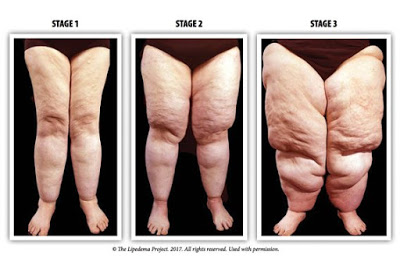Lipoedema, a condition that causes abnormal swelling and fat deposits on women’s legs, is thought to affect around 11% of females across the world. But the real number could be much higher.
This is why it is often misdiagnosed as obesity. In many cases women are too embarrassed to go to their doctor because they think they’re simply overweight and will be shamed for eating too much. In reality, there’s nothing they can do to prevent this condition.
Could I have lipoedema?
Lipoedema (also known as lipedema) is a chronic condition where there’s an abnormal build up of fat cells in the legs, thighs and hips, and sometimes also in the arms. There are three main episodes in a woman’s life when symptoms start; puberty, during pregnancy and menopause, but most women first notice a problem between the ages of 18-25 years.
In the beginning, limbs become swollen, spongy and feel heavy. Next, they become lumpy with fat deposits that resemble cellulite but are firmer. As the condition progresses, the deposits of hard fat grow larger and can become painful. Eventually mobility is affected as it becomes uncomfortable to walk or stand for too long. Balance is also impaired meaning you might become more clumsy.
One indication that you are suffering from lipoedema is if your lower body region is size-wise out of proportion compared to the rest of your body - giving your figure an exaggerated pear shape. You may have tried dieting without making any difference. Another sign is that the skin feels cold to the touch and bruises very easily.
What causes lipoedema?
Little is known about lipoedema but it is thought to be a hereditary condition linked to hormones. It is possible for the condition to skip a generation, so you could inherit it from your grandmother, even if your mother isn’t affected. Unfortunately there’s no cure for lipoedema at the moment.
How can lipoedema be treated?
Right now, the most effective way to treat this tissue enlargement caused by lipoedema is with liposuction. Studies have found that using liposuction in patients with lipoedema reduces tissue bulk, pain and bruising, and improves mobility, functioning and quality of life (Reich-Schupke et al 2012; Peled & Kappos, 2016).
At Ocean Clinic Group we use a special type of water-jet assisted liposuction (WAL), known commercially as Body-jet, which is an especially gentle and effective method. Fat is detached using a fan-shaped water-jet, and then removed through aspiration.
The benefit of this type of liposuction is that the surrounding tissue, nerves, lymph vessels and blood vessels experience far less trauma, which is extremely important in the treatment of lipoedema. It means there will be quicker wound healing and recovery, and less pain and discomfort, while the risk of complications is also reduced.
Typically, 1.5 to 6.5 litres of fat can be removed per liposuction session. Most patients will require two to three operations to complete treatment.
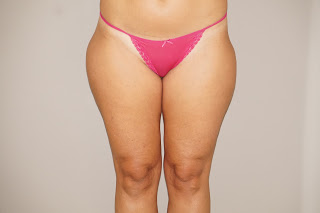
Before
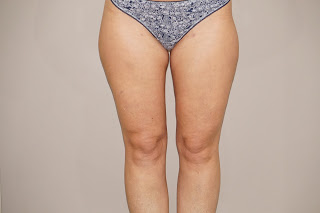
After
Why is WAL is the best choice for treating lipoedema?
Water-jet assisted liposuction ensures that no damage occurs to the body’s lymphatic system. In lipoedema patients this is particularly important because the flow of lymph fluid within the lymphatic system is vital to reducing oedema (fluid build up).
Unlike other types of liposuction, water-jet assisted liposuction can be performed under local tumescent anesthesia (not general anesthesia), which further protects the lymphatic system against stress.
Research shows lymph-sparing WAL liposuction yields good long term results in reduction of lipoedema pain and in stopping the progression of this disease (Stutz & Krahl, 2008; Rapprich et al., 2011, 2012).
What is the after care following liposuction for lipoedema?
Following liposuction you will be required to wear compression garments. These may only be necessary for a few weeks in early-stage cases, but more advanced cases require long-term use of compression garments.
Compression garments encourage the blood- and lymph fluid flow and therefore help to prevent the worsening of lipoedema symptoms. The garments also encourage fluid within the tissues to move towards the root of the limb, where it can be drained away more easily.
If you receive liposuction surgery at Ocean Clinic, we will also arrange a course of lymphatic drainage massage and ultrasound therapy sessions. These treatments are used to stimulate lymphatic flow, help to reduce fluid build up, reduce swelling and speed up healing.
What are the long term results from liposuction for lipoedema?
Liposuction can’t cure lipoedema but it can treat and manage the symptoms. It can greatly improve the appearance of affected limbs, but the results offered by this treatment are more than cosmetic. Removing excess fat will alleviate pain, increase mobility and and prevent the progression of lipoedema which can severely limit a patient’s daily activities.
The longer term benefits are evidenced by a study of 112 patients, who had prior undergone tumescent liposuction. Hereby positive changes could be found in seven parameters. These included pain, bruising, oedema, mobility and quality of life (Schmeller et al, 2012; Baumgartner et al; 2016).
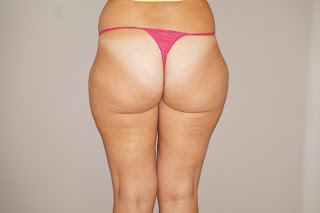
Before
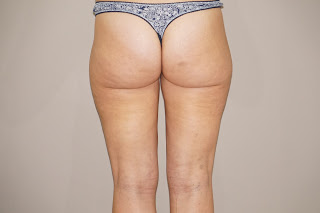
After
How can I get liposuction treatment for lipoedema?
While experts agree that liposuction for lipoedema is not a cosmetic procedure but something that is medically necessary, most national health services and private health insurance providers are unwilling to cover this treatment.
Even when liposuction is available through the national health service, it’s likely patients will have to join a long waiting list. Unfortunately, as the condition can develop rapidly, this can result in patients becoming increasingly immobile. The best outcomes can be achieved when the condition is treated in its early stages, so if you believe you may have lipoedema, it’s important to try to get a diagnosis as soon as possible.
If you have been diagnosed with lipoedema, consulting with a plastic surgeon will help you understand what can be done in your case and the cost of treatment. Armed with this knowledge, you can take control of your future. Many clinics, including Ocean Clinic, offer payment plans, to help you manage the cost.
Contact Ocean Clinic Group for a consultation at our Marbella clinic.
